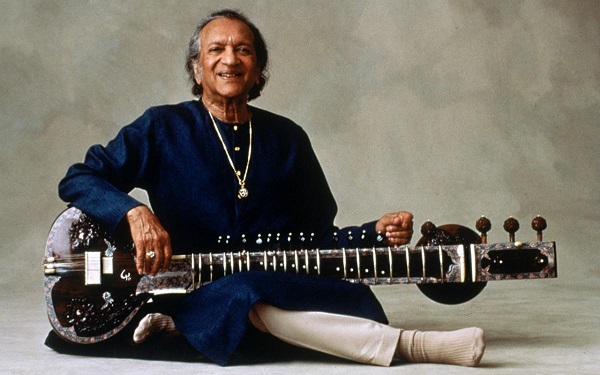THIE WEEK’S MUSE
RAVI SHANKAR

“I try to give to my music the spiritual quality, very deep in the soul, which does something even if you are not realizing it or analyzing it – that’s the duty of the music.”
Ravi Shankar was an Indian sitar player and composer. He became the world’s best-known export of North Indian classical music and found huge success as a part of western popular music from the 1960s, until his death in 2012.
Shankar was born in 1920 and spent his early childhood in Benares on the River Ganges in northern India, a culturally progressive city that has long been associated with learning and music. Aged 10, he went to Paris with his brother’s dance group, eventually dancing, performing, and later playing music. By the mid 1930s, he had traveled to the United States, learned French, and immersed himself in Western classical music, jazz, and developed a love of cinema.
After returning to India to train as a classical musician, under renowned teacher Allauddin Khan, Shankar began his recording career aged 25. He founded the Indian National Orchestra, and his compositions for the orchestra combinied Western and classical Indian instrumentation – an approach he would be drawn to for the rest of his life.
“I have always had an instinct for doing new things. Call it good or bad, I love to experiment.”
He popularized unusual ways of playing the sitar, looking for rhythmic novelties and using unconventional rhythmic cycles in his composition, using musical structures and frameworks as jumping off points for improvisation and experimentation.
Both his skills as a serious musician and his fame, were immortalized after appearances at two events that have come to define the 1960s in the US. The first was at the Monterey Pop Festival in 1967, where he was warmly received by an unsuspecting audience, most of whom were hearing his energetic, emotionally charged Indian music for the first time.
While complimentary of the artists at the festival, he said he was “horrified” to see Jimi Hendrix set fire to his guitar. “That was too much for me. In our culture, we have such respect for musical instruments, they are like part of God.” As a result of this appearance his stock rose as a central figure in the US counterculture that began to appropriate Indian culture and music as emblems of change.
Two years later he performed at Woodstock, playing a memorable set to a transfixed, rain-soaked crowd on the opening night. His performance was immortalized in the subsequent film released the following year.
A long-term musical relationship with George Harrison that continued for the rest of their lives, cemented Shankar’s global reputation and continued to bring India music to Western audiences.
The New York Times said, Shankar’s “interactions throughout his career with performers from various Asian and Western traditions—including violinist Yehudi Manuhin, flutist Jean-Pierre Rampal, and saxophonist John Coltrane—created hybrids that opened listeners’ ears to timbres, rhythms, and tuning systems that were entirely new to them.” He died in Chicago in 2012.
HAPPENING

We are going dark for a few weeks to give our team a chance to spend time with family and friends and for some much-needed rest and relaxation.
This week is your last chance to enjoy art, food, and music at the Center until we return in 2023.
Gift cards and gift memberships are available all week. For every $100 in gift cards, we give you an extra $20 to spend in 2023!
The entire campus will be closed to the public from December 19 – January 9.
However, we will reopen the galleries for our one-day Winter Magic Antique Show on January 1, 2023, and then reopen our business office and galleries on January 9, as we welcome in our Members’ Show 2023!
We thank you for your support throughout the year and can’t wait to see you at the Center!
Happy holidays to you and yours,
Your Cultural Center Team
